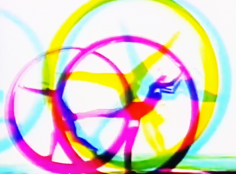doris chase
Circles II
source: youtube
“Circles II” was created by Doris Chase in 1971. This piece features her collaboration with dancer/choreographer Mary Staton who is dancing with Chase’s sculpture. This was shot with 16mm black and white film and then Chase created effects by overlaying different films. Later she added color..
.
.
.
.
.
.
.
source: washingtonedu
Doris Chase has achieved international stature as a pioneer in the field of video art since she moved from Seattle to New York City in 1972. An artist of remarkable and continuous creativity, Chase now divides her time between her video headquarters in New York and a Seattle studio where she works on new projects in painting and sculpture.
Beginning as an innovative painter and sculptor in Seattle in the 1950s, Chase created sculpture that was meant to be touched and manipulated by the viewer. Chase then developed large-scale kinetic sculptures in collaboration with choreographers, and her art was set in motion by dancers. In New York, her majors contribution to the evolution of artists’ video has been her work in videodance. On videotape, dancers and sculpture evolve into luminous abstract forms which represent some of the most sophisticated employments of video technology by an artist of the 1970s. In the 1980s, Chase began working in the nascent genre of video theater. In these productions, she uses the imtimacy of the video screen to achieve a new synthesis of visual and dramatic art. Her video theatre compositions present multicultural and social commentary, utilizing scripts by writers such as Lee Breuer, Thulani Davis, and Jessica Hagedorn in the “Concepts” series. Collaborating with actresses Geralding Page, Ann Jackson, Roberta Wallach, Joan Plowright, and Luise Riner in the “By Herself” series, she focuses on the viewpoints and experiences of older women. Today, coming full circle, Doris Chase in Seattle is exploring a renewed interest in painting and sculpture as well as in the modernist aesthetic she never really ceased pursuing, even during her most adventuresome multimedia years.
.
.
.
.
.
.
.
source: finslab
Doris Totten foi uma pintora, professora e escultora, mas é mais lembrada por seu pioneirismo na produção de obras importantes na história da videoarte. Ela era um membro da Escola Noroeste. Nos primeiros anos de sua carreira, o preconceito de gênero estava vivo e bem entre o estabelecimento da arte Northwest, que tendia a tratá-la como uma dona de casa com pretensões. Doris teve uma carreira substancial como uma pintora e escultora antes dela partir para Nova York, onde ela fez vídeos inovadores. Prosseguindo a sua arte era mais fácil do que em Nova York, no Noroeste, onde ela sofreu condescendência considerável por ser do sexo feminino. Sua arte posterior, que muitas vezes defendeu a causa das mulheres, é uma indicação da dor que esse prejuízo causou.


